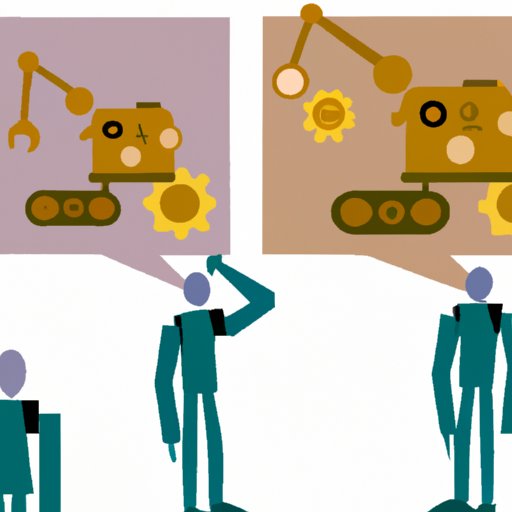Introduction
Automation is the process of using technology to perform tasks that were once done by humans. Automation has been used in many industries to increase efficiency, reduce costs, and improve accuracy. While automation has its benefits, it also has a number of drawbacks that can have serious consequences for people, jobs, and the economy.
Loss of Job Opportunities due to Automation
One of the major drawbacks of automation is the loss of job opportunities. According to a recent study by the McKinsey Global Institute, “as many as 375 million workers—or roughly 14 percent of the global workforce—may need to switch occupational categories by 2030 due to automation.” This means that jobs that once required humans to do them will now be done by machines, leading to massive job losses.
The impact of automation on workers and the economy can be devastating. Not only does it lead to job losses, but it can also result in lower wages for those who are able to find work. This can lead to increased poverty and inequality, which can further destabilize the economy.

Inaccurate Results from Automated Processes
Another major downside to automation is that it can lead to inaccurate results. Automation systems rely on programmed instructions, which can be prone to errors. In addition, automated processes can be limited in their ability to interpret data accurately. This can lead to incorrect decisions being made, which can have serious consequences. As noted by the International Labour Organization, “if automated decision-making is not adequately monitored, errors may go undetected and could lead to significant financial losses.”
In order to avoid these potential errors, organizations must take steps to ensure the accuracy of their automated systems. This includes regular testing and monitoring of the system, as well as ensuring the data being used is up to date and accurate.
Increased Risk of Cybersecurity Breaches
Automation systems can also pose an increased risk of cybersecurity breaches. As noted by the National Institute of Standards and Technology, “automation systems may contain vulnerabilities that can be exploited by malicious actors.” These vulnerabilities can allow attackers to gain access to sensitive information or disrupt operations. This can lead to financial losses, reputational damage, and other serious consequences.
In order to mitigate the risk of a cybersecurity breach, organizations should take steps to secure their automated systems. This includes regularly patching and updating the system, implementing adequate security measures, and conducting regular risk assessments.

High Cost of Implementing and Maintaining Automation Systems
Implementing and maintaining an automation system can be expensive. Organizations must invest in the necessary hardware and software, as well as hire personnel to manage the system. This can be a significant cost, particularly for smaller businesses. In addition, automation systems require ongoing maintenance and upgrades, which can add to the cost of ownership.
Organizations must carefully consider the cost of implementing and maintaining an automation system before deciding whether it is the right choice for their needs. They should also take into account any potential savings they may realize from using automation.
Diminished Quality of Outputs
Automation systems can also lead to a decrease in the quality of outputs. Automated processes lack the creativity and flexibility of humans, and are unable to detect subtle nuances that may affect the quality of the output. As noted by the Harvard Business Review, “automation eliminates the human touch that can make products stand out in the market.” This can lead to a decrease in customer satisfaction and sales.
Organizations must take steps to ensure the quality of their outputs. This includes regularly monitoring the performance of the system and making adjustments as needed. It also requires investing in quality control measures such as testing and inspections.
Unethical Use of Automation
Automation can also be used for unethical purposes. For example, automated systems can be used to collect and analyze large amounts of data, which can then be used for targeted marketing or other manipulative tactics. As noted by the World Economic Forum, “these technologies can be used to manipulate individuals or groups in ways that are unethical, or even illegal.”
Organizations must take steps to ensure that their automated systems are not being used for unethical purposes. This includes implementing safeguards to protect data, as well as regularly monitoring the system for any signs of misuse.

Negative Impact on Human Interaction and Socialization
Finally, automation can have a negative impact on human interaction and socialization. Automation systems can reduce the need for humans to interact with each other, which can lead to decreased social skills and feelings of isolation. As noted by the American Psychological Association, “people may become overly dependent on automation, leading to reduced motivation and engagement in social activities.” This can have a detrimental effect on mental health.
Organizations must take steps to ensure that automation does not negatively impact human interaction and socialization. This includes providing employees with opportunities to interact with each other, as well as encouraging the use of automation in ways that do not replace human interaction.
Conclusion
Automation can have a number of negative impacts on people, jobs, and the economy. These include loss of job opportunities, inaccurate results, increased risk of cybersecurity breaches, high cost of implementation and maintenance, diminished quality of outputs, unethical use of automation, and negative impact on human interaction and socialization. Organizations must take steps to mitigate these risks in order to ensure that automation is used responsibly and ethically.
(Note: Is this article not meeting your expectations? Do you have knowledge or insights to share? Unlock new opportunities and expand your reach by joining our authors team. Click Registration to join us and share your expertise with our readers.)
